What Is A Rigid-Flex PCB?
Custom Rigid-Flex PCB Fabrication & Supply
As a leading China flex PCB supplier, we specialize in high-quality flex circuit manufacturing—from rapid-turn prototyping to full-volume flexible PCB fabrication. Upload your Gerber files now for a fast, reliable quote.
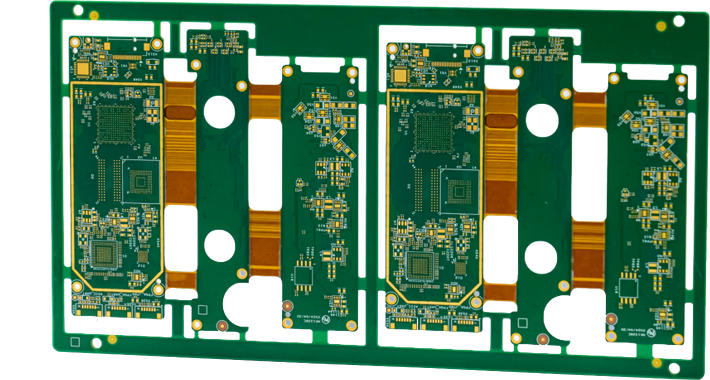





What Is A Rigid-Flex PCB?
Meaning
Rigid-Flex PCBs combine the best of both rigid and flexible circuit technologies into a single, unified board. This hybrid structure allows for complex three-dimensional designs, enabling electronic components to be mounted on both rigid sections while flexible layers provide interconnectivity across dynamic or confined spaces.
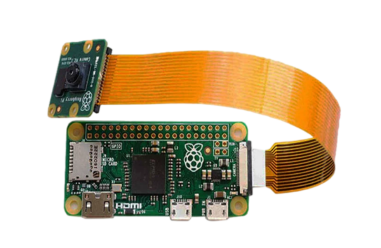
Difference
Unlike traditional rigid boards that require connectors or cables for interconnection, Rigid-Flex PCBs streamline the overall design by eliminating these components—resulting in improved reliability, reduced weight, and enhanced signal integrity.
Materials
These boards are widely used in mission-critical and compact applications such as medical devices, aerospace systems, military equipment, cameras, and wearables, where high mechanical reliability, space savings, and resistance to vibration and bending are essential.
Why Choose Us
1
Responsive Customer Service
We specialize in full-cycle rigid-flex PCB production—from prototyping to mass production. Our in-house facilities are equipped with advanced processing lines tailored for complex rigid-flex structures, ensuring tight process control and consistent quality.
2
Engineering-Driven Support
Our experienced engineering team provides comprehensive DFM (Design for Manufacturability) analysis, helping customers optimize stack-up, impedance, and bend radius before fabrication begins. We support Gerber, ODB++, and IPC standards for seamless collaboration.
3
Certified Quality & Advanced Equipment
All of our manufacturing processes are ISO 9001, UL, and RoHS certified. With laser drilling, precision lamination, and AOI/X-ray inspection, we meet the high standards required for aerospace, military, and medical applications.
4
Fast Turnaround & Global Delivery
We offer expedited lead times for both prototypes and high-volume orders. With a flexible production model and global logistics network, we deliver to customers worldwide—on time, every time.
5
Responsive Customer Service
From quote to shipment, our dedicated support team provides 24/7 technical assistance and order tracking. Whether you’re a startup engineer or a Tier-1 OEM, we treat every project with precision and urgency.
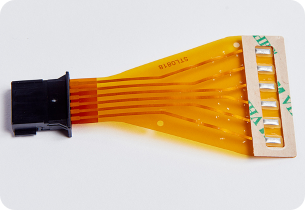
Product Showcase
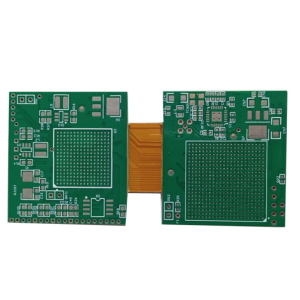
2R1F Rigid-Flex PCB Structure
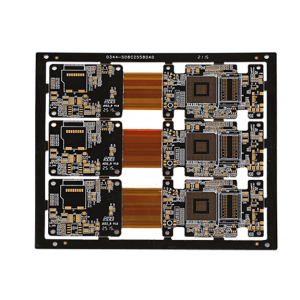
4R2F Panelized Rigid-Flex PCB
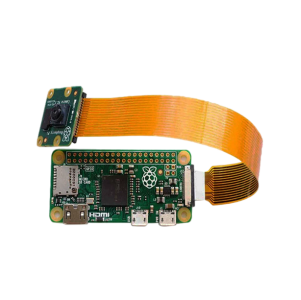
Camera Module with FPC Interconnect
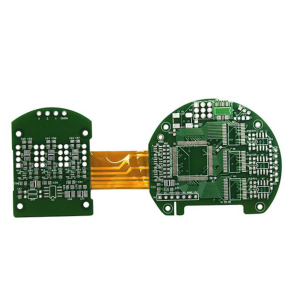
Custom-Shaped Dual Rigid–Single Flex PCB (2R1F) for Circular Device Integration

High-Density Multi-Connector Rigid-Flex Interconnect PCB

High-Speed Rigid-Flex PCB for BGA and Connector Integration
Manufacturing Process
01. Material Preparation
Select high-performance polyimide and FR4 laminates based on layer stackup and design.
02. Inner Layer Imaging & Etching
Create fine copper traces using photolithography and precision chemical etching.
03. Lamination of Rigid and Flex Layers
Bond rigid and flexible layers into a unified structure using heat, pressure, and alignment control.
04. Drilling & Copper Plating
Drill microvias and through-holes, then plate with copper to form reliable interlayer connections.
05. Outer Layer Imaging & Patterning
Define and etch the outer circuitry, ensuring signal integrity and trace accuracy.
06. Surface Finishing
Apply finishes like ENIG, HASL, or OSP to protect pads and improve solderability.
07. Coverlay & Stiffener Application
Add protective coverlays over flex zones and stiffeners under connectors or components.
08.Profiling & Final Testing
Laser-cut or route board outlines, then perform 100% E-test and visual inspection.
Capabilities
| Capability | Parameters |
|---|---|
| Layer |
26L |
| 26L |
0.065 mm/0.065 mm |
| Min Hole/Pa Size |
0.10/0.35 mm |
| Rigid-Flex Thickness |
0.25-6.0mm |
| Drilling Accuracy |
+/-0.05 mm |
| PTH Diameter Tolerance |
+/-0.05 mm |
| Max Wpnl Size |
620 mm x 500 mm |
| Finish Copper (Flex Part) |
0.5-2oz |
| Finish Copper (Rigid Part) |
1-4oz |
| Surface Treatment |
ENIG Electric Gold IM-Ag Electric Ag HASL HASL-LF IM-Sn Electric Sn OSP Caborn Pt NI-Pd-AU |
| Max Board Thickness: PTH Diameter |
13:01 |
| Build Time |
7-20 Days |
Application Industries






Application Industries
Design for Manufacturability
Every project receives a free DFM check before fabrication. We analyze your stack-up, trace width, bend radius, drill strategy, and impedance control to ensure your design is ready for production.
01
Stack-Up Optimization & Material Guidance
Our engineers assist with optimal material selection (PI, FR4, adhesiveless laminates), copper weights, and dielectric configurations based on your electrical and mechanical requirements.
02
Comprehensive File Support
We accept Gerber, ODB++, IPC-2581, and other mainstream formats. Our CAM team works closely with you to clarify build instructions, panelization needs, and stiffener placements.
03
Responsive Technical Communication
Get fast responses and expert feedback during the quoting, design, and production stages. We’re available via email, online chat, or phone to ensure your project moves forward smoothly.
04

FAQ
We can handle virtually all BGA types, including PBGA, CBGA, µBGA, FCBGA, WLCSP, and stacked BGA.
Flex PCBs are primarily made from polyimide (PI) or polyester (PET) substrates with copper foil layers. We also use adhesiveless laminates for high-reliability applications. Coverlays, stiffeners (FR4 or stainless steel), and surface finishes (ENIG, OSP) are added depending on the design.
Lead times depend on complexity and quantity:
- Prototype Flex PCBs: 3–7 business days
- Production Runs: 7–20 business days
Expedited options are available for urgent projects — contact us for a custom quote.
Yes. We offer full Rigid-Flex PCB manufacturing, including HDI and multilayer designs. Our process supports complex 3D assemblies and ensures precise layer registration and bend reliability.
Yes. We offer full Rigid-Flex PCB manufacturing, including HDI and multilayer designs. Our process supports complex 3D assemblies and ensures precise layer registration and bend reliability.
- Flex PCBs use flexible base materials and are designed to bend, fold, or twist during use.
- Rigid PCBs are built on FR4 substrates and are not designed for movement.
Flex PCBs save space, reduce weight, and improve durability in dynamic environments.
Absolutely. Our engineering team offers free DFM reviews, helping you optimize your design for manufacturability, cost efficiency, and long-term reliability. Upload your Gerber files, and we’ll evaluate them before production begins.
Yes. All our Flex PCBs are RoHS-compliant and manufactured to IPC-6013 and IPC-A-600/610 Class 2 or Class 3 standards, depending on application needs. Certifications and test reports are available upon request.
Yes. All our Flex PCBs are RoHS-compliant and manufactured to IPC-6013 and IPC-A-600/610 Class 2 or Class 3 standards, depending on application needs. Certifications and test reports are available upon request.
Yes. All our Flex PCBs are RoHS-compliant and manufactured to IPC-6013 and IPC-A-600/610 Class 2 or Class 3 standards, depending on application needs. Certifications and test reports are available upon request.
